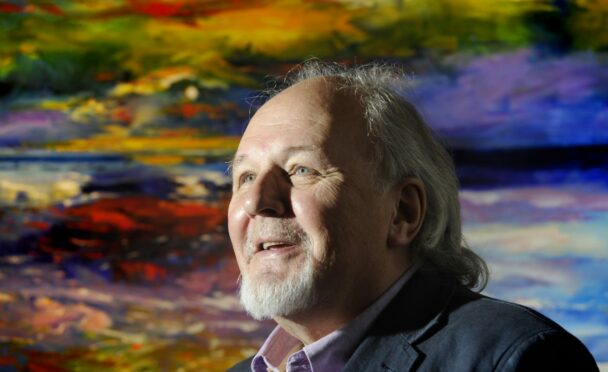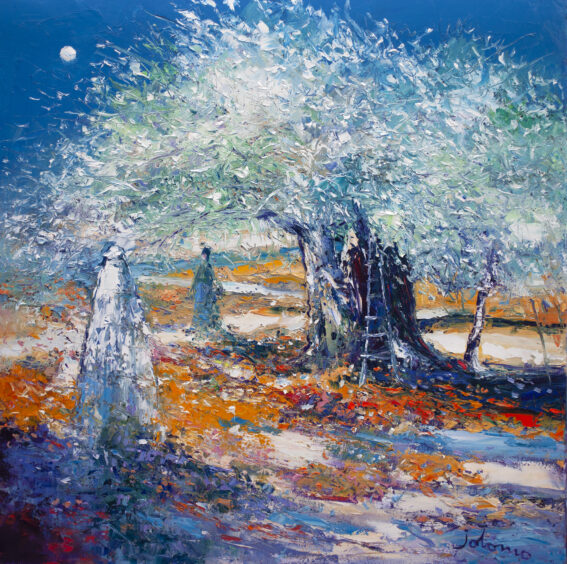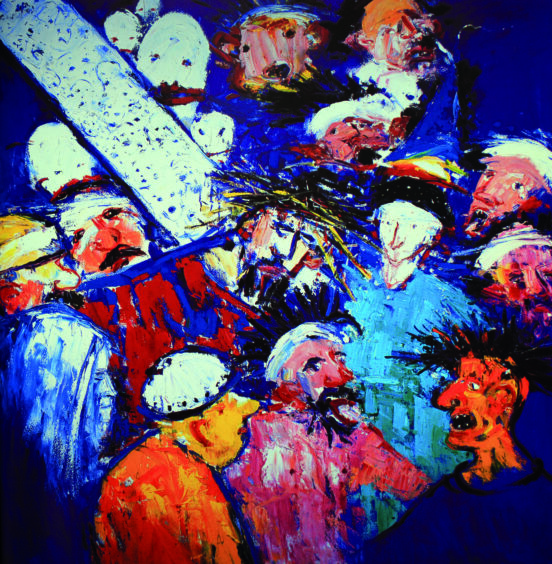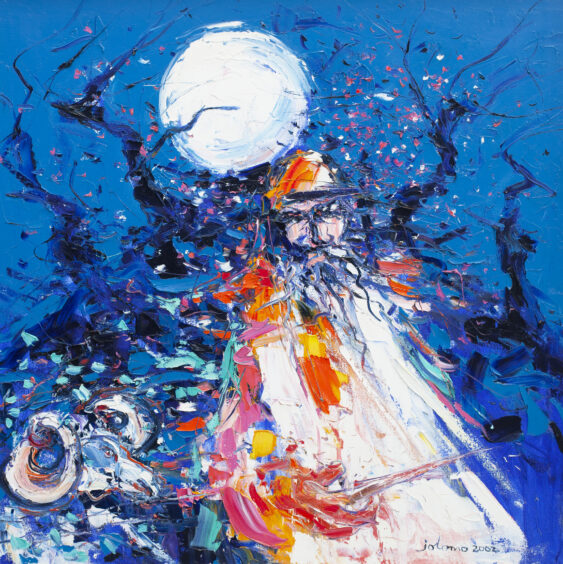
His wild landscapes ablaze with colour have won worldwide acclaim and are, to art lovers, heavenly but John Lowrie Morrison’s religious paintings are, to him, just as important.
Jolomo, as he is widely known, is also a lay reader in the Church of Scotland, preaching at kirks around the country. Occasionally, those two worlds collide and produce striking religious imagery on canvas, some of which is being showcased in Jolomo: A Passion For Colour.
“Everyone thinks I’m a landscape painter so people might be quite amazed by some of these,” said Morrison. “Ever since I was a wee boy, I’ve done semi-religious and purely religious paintings.
“When I was 11 or 12, I did an oil painting on a canvas board which was a copy of 17th Century Italian painter Murillo’s nativity, and that’s when I started thinking, I’m going to paint like this. In amongst all the classically trained stuff like still life and landscape, I always paint religious material, too.”
Paintings in the retrospective exhibition at Ayr’s Maclaurin Gallery also relate to important events in Morrison’s life, from the textiles he trained in at Glasgow School of Art and met his wife Maureen through, to a set of paintings depicting the young people he met in care in the early 1970s. Today, the couple are long-time vice presidents of Carers Trust UK.
“As an artist, you don’t prepare for a retrospective – most are gone by the time they happen! – so I’m fortunate to be one of a few artists to receive one while still alive,” he said. “I have a big collection of drawings and paintings going back 60 years, so there’s a lot of material people haven’t seen before. There are hundreds of thousands more – maybe one day when I’m long gone there might be a bigger exhibition and people will see more of them.”
Morrison, who was brought up in Maryhill, Glasgow, has been prolific in his output since he gave up teaching to become a full-time painter in 1997. At that time, he was producing several paintings a day, and while he has since slowed down, his yield is still incredibly high.
“A lot of artists are prolific,” he said. “Joan Eardley said painting is like breathing and that’s me – I get up in the morning, go into the studio and go as far as I can go. The days are starting to shorten now I’m in my 70s, but it’s still there. I was firing out three or four a day 20 years ago but a lot of them were tiny. The bigger ones take a few days to a few weeks, and the older I get the more complicated I become, so I’m lucky if I do one a day now.”
Age has done little to temper dad-of-three Morrison’s productivity and neither did lockdown. He continued unabated and has discovered that more and more people are looking to buy one of his landscape paintings during the pandemic – perhaps as a replacement for a holiday.
“We discovered people were wanting paintings and it’s going like a fair – it still is. I can’t get enough paintings out,” he said.
“I think people are feeling they had money to go on holiday and can’t, so they’re buying a painting to cheer themselves up. I’ve been doing some Dutch and Italian landscapes recently and a lady who was supposed to be going to Venice bought my painting of Venice instead. If anything, my creativity was better in lockdown. Maureen does the office administration, my youngest son Simon is my business manager, and his partner Morven frames the pictures, so it’s a family operation.”
While his paintings have been bought by celebrities including Sting, Madonna and Simon Le Bon, Morrison doesn’t get star-struck.
“It’s nice to have all these different actors and musicians interested, but it’s more important to me that it’s accessible to the man on the street. I paint for myself but, in saying that, I do like to cheer people up and put a smile on their face, and if one of my prints can lift someone’s spirit in a hospital waiting room, or in their hallway or bedroom at home, that’s wonderful.”
The queen of pop might not have left an impression, but Her Majesty certainly did. Morrison has preached for The Queen and Prince Charles at Crathie Kirk, and was also invited to lunch at Buckingham Palace a few years ago. “Both were lovely to meet and to talk with. The Queen is a hoot, a laugh a minute,” he said.
It seems a long way from his childhood growing up in Maryhill, and maybe it is but Morrison always knew he was destined to paint.
“When I was four, just starting at Dowanhill Primary School, I was given a piece of paper and some pastels, and I thought I’d dunk it in water because my mum had shown me that, and I just loved it and said it’s what I wanted to do,” he continued.
“I decided at eight I was going to art school, not realising I needed O grades. My mum was a fancy chocolate box maker – she was wonderful at it – and she worked round the corner from the School of Art. Sometimes she would take me round and tell me I would go there one day.
“I sold my first painting when I was about 15. It was called The Purple Mountain, a copy of a painting by my grandfather, Henry Lowrie, who was a watercolour artist.
“I displayed it on the railings at the Botanic Gardens in Glasgow and then I put it into a civic art exhibition in 1963, and it sold for a tenner. There is a watercolour and an oil painting in the exhibition I did when I was eight, so it really is a retrospective.”
Jolomo: Passion For Colour, Maclaurin Gallery, Ayr, until September 5
Prints of peace
John Lowrie Morrison reveals the stories behind three of his favourite religious works.
A MEETING WITH CHRIST

This is one of my best. It’s based on a photograph a friend sent me of the olive trees in Gethsemane. They’re more than 2,000 years old and I thought, I’m going to paint that because Christ was alive when those trees were growing.
I decided he might have met someone there, maybe a lady who came to follow him or that he healed. I put a ladder in the picture because I imagined there was maybe a wee man up the tree picking olives when Jesus was trying to save this woman’s soul.
That’s just my stupid humour – life can be dreadful and I like to make people smile sometimes.
CHRIST CARRYING THE CROSS

I started this in 1991. I decided I’d do a big (it’s 5ft square) pre-crucifixion scene, with Christ carrying the cross and all of these horrible people shouting at him and demons flying through the air.
I’d been doing some drawings of children to do with the Bosnian War and I put their wee faces on the main spar of the cross to show all of the terrible things that were happening there.
My wife Maureen is in the painting as Mary, down to the bottom left. You don’t see it so well, but I like to put people I know in my paintings from time to time.
RAM IN THE THICKET

I’ve always loved the story of Abraham about to slit his son’s throat but being stopped by the ram coming out of the thicket.
As a wee lad at Partick East Church in Glasgow, I remember these horrible religious paintings at Sunday school, like John the Baptist having his head cut off.
It scared the living daylights out of me and when I think back I wondered why they would put that on a Sunday school wall. I put a really sharp knife in the painting so that it was scary – but I hope I don’t scare any children!

Enjoy the convenience of having The Sunday Post delivered as a digital ePaper straight to your smartphone, tablet or computer.
Subscribe for only £5.49 a month and enjoy all the benefits of the printed paper as a digital replica.
Subscribe